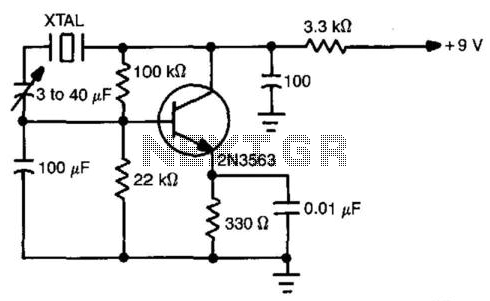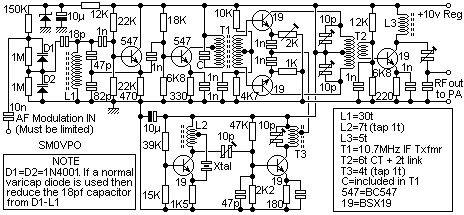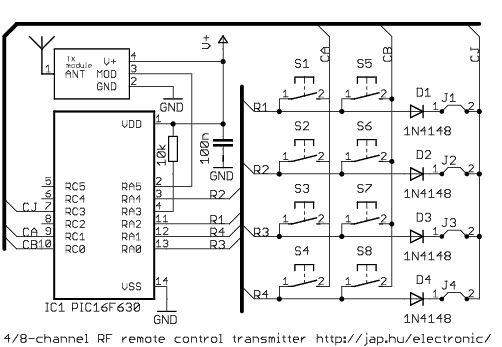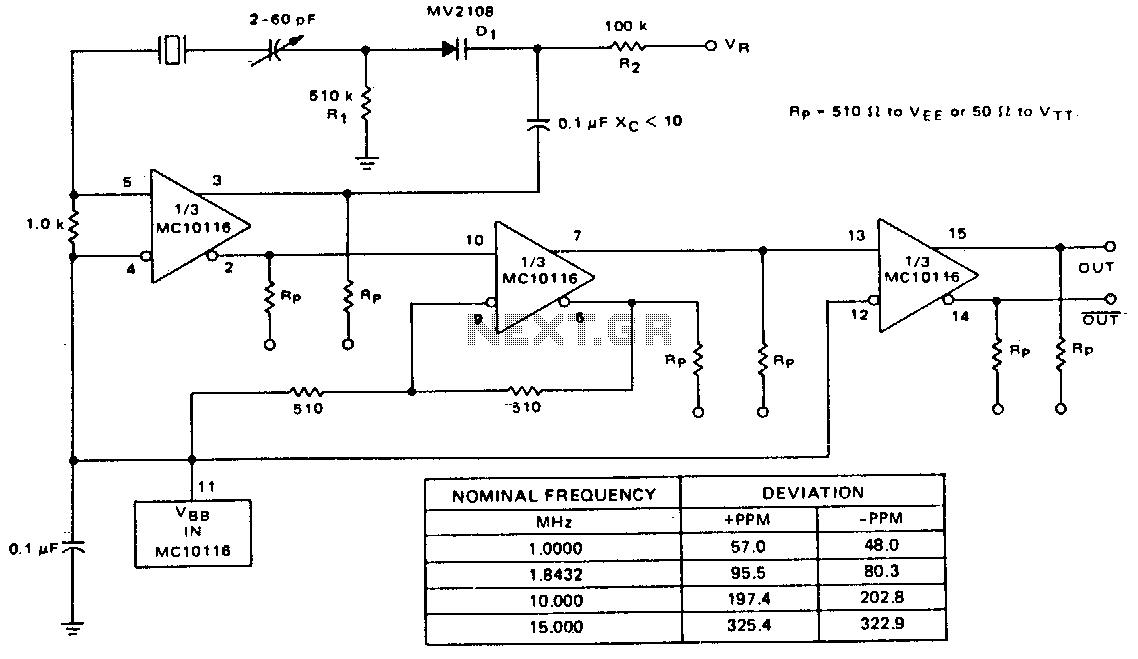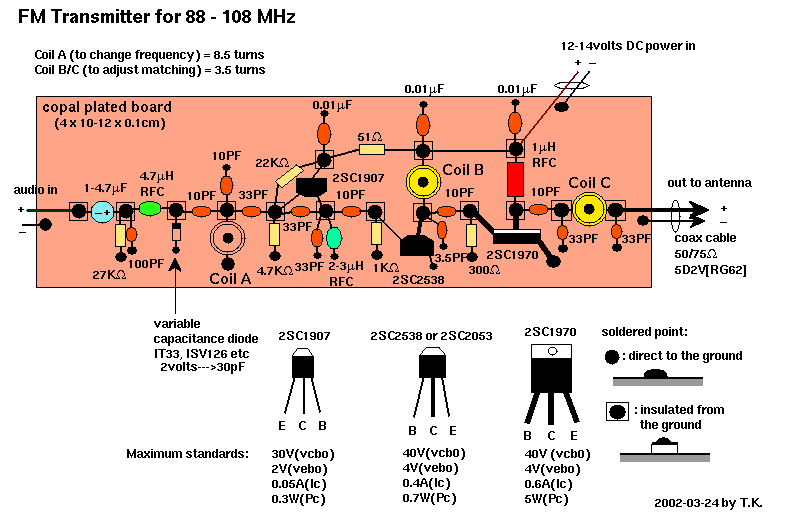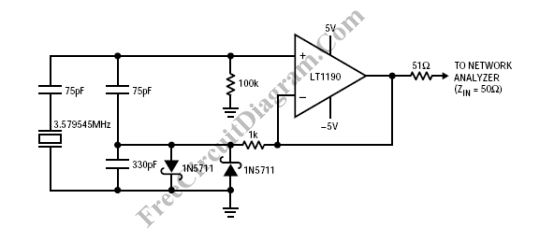
fm transmitter colpitt oscillator
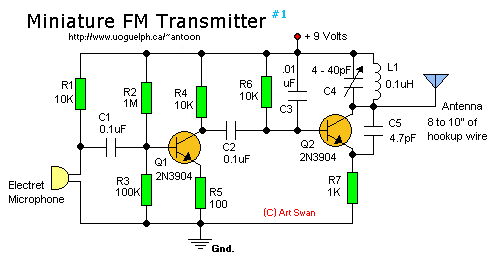
C1 takes the DC-decoupled voltage from the microphone, amplifies it via Q1, then C2 decouples it again. R6 and C3 form a low-pass filter, but once the signal reaches Q2, the circuit accomplishes frequency modulation. The frequency deviation is achieved by changes to the base voltage, which affects the base-collector capacitance. The tuned circuit also changes when anything approaches the antenna, and it drifts as the battery discharges. The goal is to build a simple transistor-level FM transmitter for personal amusement, serving as an exercise in engineering knowledge, particularly in Communications Systems and Signal Processing.
A comprehensive analysis of the described FM transmitter circuit reveals several key components and their roles in achieving frequency modulation. The microphone captures audio signals and converts them into a corresponding electrical signal. This signal is initially decoupled by capacitor C1, which removes any DC offset, ensuring that only the AC component of the audio signal is amplified.
Transistor Q1 acts as the primary amplifier in the circuit. It increases the amplitude of the audio signal, allowing it to drive subsequent circuit elements effectively. After amplification, capacitor C2 further decouples the signal, ensuring that any remaining DC components do not affect the following stages of the circuit.
The combination of resistor R6 and capacitor C3 forms a low-pass filter that attenuates high-frequency noise, allowing only the desired frequency components to pass through to the next stage. This filtering is crucial for maintaining the integrity of the audio signal before it is modulated.
In the frequency modulation (FM) stage, transistor Q2 plays a vital role. The frequency modulation is achieved by varying the base voltage of Q2, which directly influences the base-collector capacitance. This variation in capacitance alters the resonant frequency of the tuned circuit, resulting in frequency deviation proportional to the input audio signal. The equation governing this modulation can be represented as cos(2πf_ct + fΔ), where f_c is the carrier frequency, and fΔ represents the frequency deviation caused by the modulating signal.
The design should also consider external influences, such as nearby objects affecting the antenna's performance and the drift in frequency as the power supply voltage decreases. To ensure stable operation, it is recommended to analyze and possibly incorporate a defined, stable frequency FM transmitter design, which includes proper coupling to an antenna and harmonic suppression filters. Searching for well-documented schematics of such FM transmitters can provide valuable insights and guidance for building a reliable circuit while adhering to the goal of maintaining a transistor-level design, avoiding the use of operational amplifiers or integrated circuits.C1 takes the DC decoupled voltage from the Microphone, amplifies this via Q1, C2 decouples it again, then R6 and C3 Low Pass Filter it, but once we get to Q2, Secondly how does this circut actually accomplish frequency modulation: Please use math on me! (I know that it should change the delta F term in the equation cos(2*pi*fc*t + F) to achieve FM, or more
correctly: cos(2*pi*fc*t + f* «(messageSignal) Frequency deviation is accomplished by changes to the base voltage. This affects the Base-Collector capacitance. The tuned circuit is also changed when anything gets near the antenna and of course it drifts as the battery wears down.
My goal is just to build a simple transistor level FM transmitter for my own amusement. More of an exercise on what I`ve learned as an engineer because I want my masters degree to be in Communications Systems and Signal Processing Edit: My bad, we were discussing a different transmitter in that thread, but some of the discussion might still be useful. I have an article on your transmitter, but I can`t find it right now. If I run across it, I`ll post. My goal is just to build a simple transistor level FM transmitter for my own amusement. More of an exercise on what I`ve learned as an engineer because I want my masters degree to be in Communications Systems and Signal Processing Do your self a favour and analyse the circuit of a REAL FM transmitter, one which has a defined, stable frequency, one which has sensible coupling to a defined antenna and harmonic supression filters.
Could you provide me with places that have such clearly explained and defined schematics It becomes rather difficult to find such high level designs. I would really rather work at the transistor level (i. e. , no OPAMPs or ICs, including multipliers) 🔗 External reference
A comprehensive analysis of the described FM transmitter circuit reveals several key components and their roles in achieving frequency modulation. The microphone captures audio signals and converts them into a corresponding electrical signal. This signal is initially decoupled by capacitor C1, which removes any DC offset, ensuring that only the AC component of the audio signal is amplified.
Transistor Q1 acts as the primary amplifier in the circuit. It increases the amplitude of the audio signal, allowing it to drive subsequent circuit elements effectively. After amplification, capacitor C2 further decouples the signal, ensuring that any remaining DC components do not affect the following stages of the circuit.
The combination of resistor R6 and capacitor C3 forms a low-pass filter that attenuates high-frequency noise, allowing only the desired frequency components to pass through to the next stage. This filtering is crucial for maintaining the integrity of the audio signal before it is modulated.
In the frequency modulation (FM) stage, transistor Q2 plays a vital role. The frequency modulation is achieved by varying the base voltage of Q2, which directly influences the base-collector capacitance. This variation in capacitance alters the resonant frequency of the tuned circuit, resulting in frequency deviation proportional to the input audio signal. The equation governing this modulation can be represented as cos(2πf_ct + fΔ), where f_c is the carrier frequency, and fΔ represents the frequency deviation caused by the modulating signal.
The design should also consider external influences, such as nearby objects affecting the antenna's performance and the drift in frequency as the power supply voltage decreases. To ensure stable operation, it is recommended to analyze and possibly incorporate a defined, stable frequency FM transmitter design, which includes proper coupling to an antenna and harmonic suppression filters. Searching for well-documented schematics of such FM transmitters can provide valuable insights and guidance for building a reliable circuit while adhering to the goal of maintaining a transistor-level design, avoiding the use of operational amplifiers or integrated circuits.C1 takes the DC decoupled voltage from the Microphone, amplifies this via Q1, C2 decouples it again, then R6 and C3 Low Pass Filter it, but once we get to Q2, Secondly how does this circut actually accomplish frequency modulation: Please use math on me! (I know that it should change the delta F term in the equation cos(2*pi*fc*t + F) to achieve FM, or more
correctly: cos(2*pi*fc*t + f* «(messageSignal) Frequency deviation is accomplished by changes to the base voltage. This affects the Base-Collector capacitance. The tuned circuit is also changed when anything gets near the antenna and of course it drifts as the battery wears down.
My goal is just to build a simple transistor level FM transmitter for my own amusement. More of an exercise on what I`ve learned as an engineer because I want my masters degree to be in Communications Systems and Signal Processing Edit: My bad, we were discussing a different transmitter in that thread, but some of the discussion might still be useful. I have an article on your transmitter, but I can`t find it right now. If I run across it, I`ll post. My goal is just to build a simple transistor level FM transmitter for my own amusement. More of an exercise on what I`ve learned as an engineer because I want my masters degree to be in Communications Systems and Signal Processing Do your self a favour and analyse the circuit of a REAL FM transmitter, one which has a defined, stable frequency, one which has sensible coupling to a defined antenna and harmonic supression filters.
Could you provide me with places that have such clearly explained and defined schematics It becomes rather difficult to find such high level designs. I would really rather work at the transistor level (i. e. , no OPAMPs or ICs, including multipliers) 🔗 External reference
